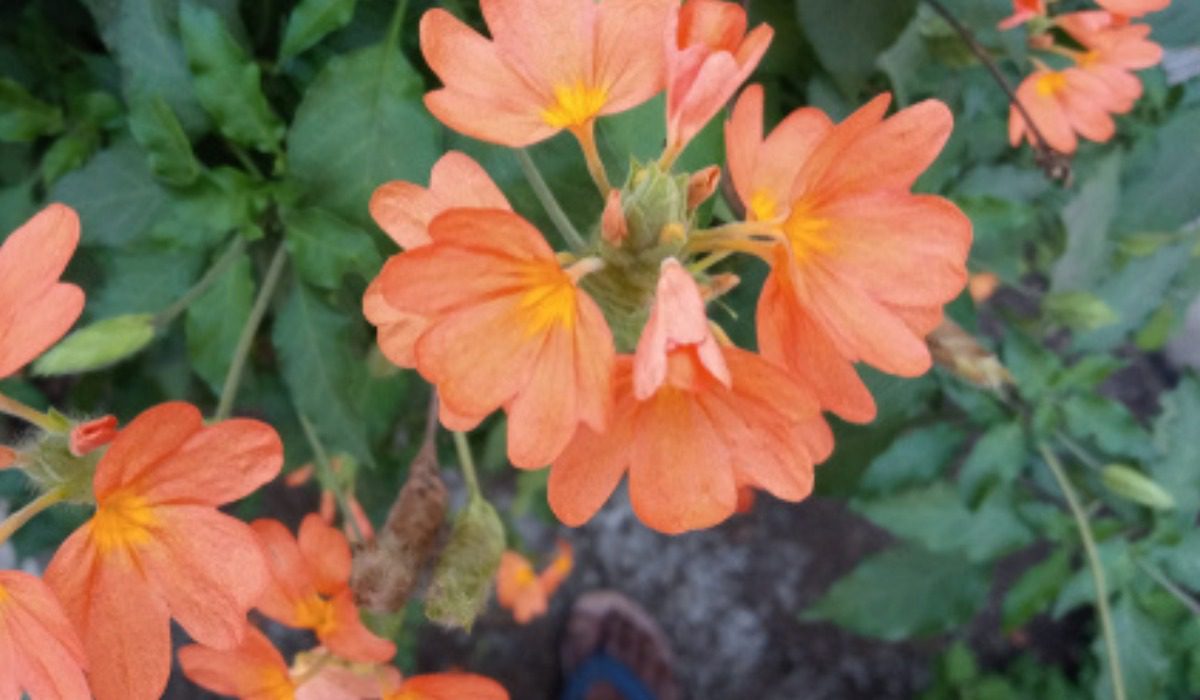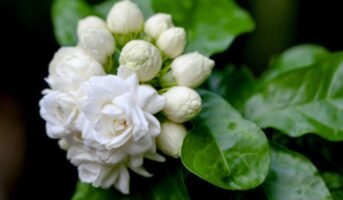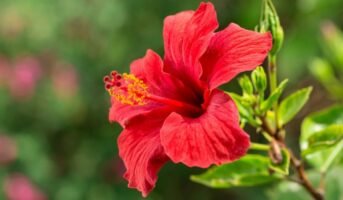The firecracker flower, scientifically known as Crossandra Infundibuliformis (or Russelia Equisetiformis in some parts of the world), is a species of flowering plant belonging to the Acanthaceae family of plants.
Native to Southern India and Sri Lanka, it is well known for its bright red flowers, which are used for a multitude of decorative purposes such as garlands, gajras, and venis.
For the place and environment they’re found in, ie. warm and sunny places, Firecracker plants make for outdoor decorations as well as indoors. They’d make for a stellar complementary addition to any Indian household, regardless of how big or small it is.

Source: Pinterest
See also: All about Wishbone Flower
What is Crossandra Infundibuliformis?
Crossandra Infundibuliformis is a flowering plant from the Acanthaceae family. It belongs to the genus Crossandra, which comprises 54 species. The plants, especially Crossandra Infundibuliformis, are widely grown for their attractive flowers.
Crossandra Infundibuliformis: Key facts
| Family | Acanthaceae |
| Common name | Crossandra, firecracker flower. |
| Plant type | Annual, perennial |
| Size when mature | Width:- 1-2 ft wide
Height:- 1-3 ft tall |
| Sun exposure | partial |
| Soil type | Loamy and well-draining |
| Soil pH | Acidic |
| Bloom time | Spring, Summer, Fall |
| Native place | India, Sri Lanka |
| Appearance | Warm, fiery red, orange and yellow flowers, waxy leaves |
These plants barely contain any toxins and are super pollinators, making them an even more suitable choice for families or parents wanting to start their children on plants and botany.
Crossandra Infundibuliformis: Natural habitat
Crossandra Infundibuliformis is known to grow in the scrub jungles, forest thickets and slopes from foothills to 1,000 m. The regions where these are found include India and Sri Lanka.
Crossandra Infundibuliformis: Varieties
Here are the common varieties of Crossandra Infundibuliformis.
-
Crossandra Infundibuliformis (Mona Wallhead)
Its blooms are salmon-pink, and it matures to a height of 12 to 18 inches. This particular species is cold-hardy, and cannot withstand temperatures below 32 °F.

Source: Pinterest
-
Yellow Crossandra, otherwise known as ‘Lutea’
Bears vibrant, golden flowers and does surprisingly well in containers, where it blooms from spring until the first frost.
Source: Pinterest
-
The orange marmalade
This plant’s incredible disease and pest resistance is its key selling point. Consisting of brightly coloured orange flowers that bloom all season long, you simply cannot go wrong with an orange marmalade crossandra for using it as an indoor decor piece.

Source: Pinterest
Crossandra Infundibuliformis: How to grow?
The Crossandra is one of the very few plants that can bloom for months on end with indirect sunlight, making it a popular houseplant. When planted outdoors under the right conditions, the firecracker plant blooms fiery red flowers that last from late spring to autumn.
When growing indoors, it is recommended to place the plant on a tray filled with pebbles and water. Don’t forget to mist it regularly in drier climates and early winters when it is particularly dry.
For the soil, peat-based potting soil that is rich in perlite is perfect for Crossandra. If you’re planting outside, incorporate peat or compost into the soil before you plant it to ensure proper drainage and an abundance of extra nutrients.

Source: Pinterest
Crossandra Infundibuliformis: Propagation
Firecracker plants can be propagated through cuttings and readily root when the cuttings are taken early during the plant’s growing season.
- Take the cuttings early in the spring season when the plant’s growth season begins. Make the cut slightly below a node. New roots emerge from the node.
- Fill the pot with potting mix (seed-starter mix).
- Dip the cuttings in rooting hormone to promote their growth.
- Now, plant the cutting in the soil. Water the soil. It is important to mist the soil regularly until it begins to grow.
- Use a plant propagation mat to provide bottom heat to the plant.
- When sprouting occurs, transplant the new plant to a permanent location.
- Potted plants may require repotting in the initial month owing to the fast growth until they begin to bloom.
How to grow Crossandra Infundibuliformis from seed?
Start seeds indoors around late winter or early spring. This helps as the Crossandra plant starts to bloom around four months after sprouting. Scatter the seeds over a seed starting tray filled with seed-starting mix. Sprinkle soil to cover them. Make sure to keep the soil moist. Place a heat mat, which will help maintain warm temperatures for sprouting.
Once sprouting begins, divide the plants into individual pots and start growing them inside in a well-lit window. Keep it out of direct sunlight, until outdoor temperatures warm. You can plant them outdoors in the garden bed once temperatures go up to 55 F or above.
Crossandra Infundibuliformis: Care tips
The Firecracker plant likes its soil slightly acidic, with a pH that ranges from 5.8 to 6.5. Use a soil conditioner if the pH isn’t as desired. Keep the soil slightly moist at all times. Not soggy, not dry, just the right amount of moisture.

Source: Pinterest
Outdoors, the firecracker plant tends to be very susceptible to droughts. You shouldn’t allow the soil to dry out completely. Come winter, reduce the amount of water to just once a week if you’re growing it as a perennial.
As far as watering a Crossandra indoors goes, it is basically the same as outdoors. In winter, switch to warm water. Crossandras like to stay cosy, and cold water may shock the roots, causing them to die.
As you can guess from its nativity, the plant tends to love hot and humid weather but loathes the cold. It is best to keep the plant in temperatures ranging from 70-75 °F. Temperatures below 55 °F tend to be severely harmful to the plant, especially the leaves.
Mist your firecracker plant regularly if you reside in arid regions, particularly more so during the growing season. For an indoor plant, place it on a tray filled with water and pebbles. Don’t let the water touch the bottom of the pot.
Fertilisation is another factor where the Crossandra gets the trophy for being one of the easiest plants to maintain. For outdoor planting, use a granular nutrient once a month. Refer to the product packaging for instructions on how much and how often to use it.
For indoor Crossandras, dilute the fertiliser to half strength and feed once every two weeks throughout the growing season. In winter, dial down the fertilisation to once a month for indoor firecrackers and once every other month for outdoor plants.
Grooming
To enhance the lush red look of the flowers, remember to cut off the old and dying flowers every once in a while during the growing season.
As for the placement and light, it is best to place the Crossandra plant in a place with indirect sunlight. Plant it outdoors under slight shade or near a north or east-facing window if placed indoors. Try to give it as much natural light as winter approaches.
Crossandra Infundibuliformis: Uses and benefits
The flowers of Crossandra are used for several purposes but are primarily used for making decorative pieces like garlands, venis, and gajras that are used in South Indian festivals.
Other uses include keeping it indoors as a complementary piece with its waxy green leaves and fiery flowers that go quite well with any sort of aesthetic setting you put it in.
The extract from the Firecracker plant is also used to treat minor headaches, aperitif, fever, pain, and also wound healing.
Crossandra Infundibuliformis: Potting and repotting
Repotting should be done only when it is necessary, as the plant is known to be fussy and may be prone to transplant shock. Repotting must be done once every three years. Make sure to provide adequate water to the plant at least a day before repotting. Choose a clay or terracotta container, two inches larger in size than the original container. Carefully move the plant to the new container. Fill it with organic coil containing perlite.
Crossandra Infundibuliformis: Common problems
Crossandra infundibuliformis plants do not face serious problems with pests or diseases. However, it is better to protect it against the common pests and insects such as mites, aphids, and mealy bugs. You may notice tiny web-like structures on the plant if it is infested. It must be treated immediately to prevent it from spreading.
FAQs
Why is indirect sunlight preferred over direct sunlight for Crossandras?
Direct sunlight poses harm to the plant, particularly its leaves to some extent.
Is any part of the Firecracker plant toxic?
No, Crossandras are one of the least toxic and pet-friendly plants out there.
Why is it called the ‘firecracker’ plant?
The term ‘firecracker’ plant is given to this species because of a very interesting phenomenon where the seed pods, when ripe, explode under rainfall or even high amounts of humidity.
Is the Crossandra a costly plant?
Crossandra plants are fairly inexpensive and are priced between Rs. 500 to Rs. 1200. This price varies through species and the region as well.
Is the Firecracker plant prone to catching diseases or attracting pests?
These plants have an impeccable resistance to diseases and pests but if you do want the best of the best, the orange marmalade cultivar of the firecracker flower family tends to have the highest resistance of any plant in the Crossandra family.
Housing News Desk is the news desk of leading online real estate portal, Housing.com. Housing News Desk focuses on a variety of topics such as real estate laws, taxes, current news, property trends, home loans, rentals, décor, green homes, home improvement, etc. The main objective of the news desk, is to cover the real estate sector from the perspective of providing information that is useful to the end-user.
Facebook: https://www.facebook.com/housing.com/
Twitter: https://twitter.com/Housing
Email: [email protected]










